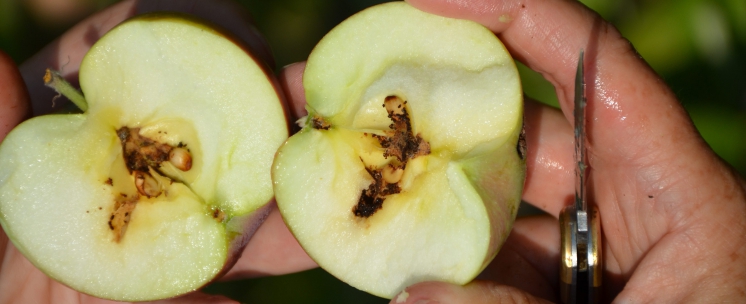In most backyard situations, the best course of action is to combine a variety of the nonchemical and chemical methods of controlling the codling moth. Because owners of host trees on private property in the SIR Program area must control the codling moth, you must take action if one or more moths are detected on your fruit trees.
-
Nonchemical Management
Tree Size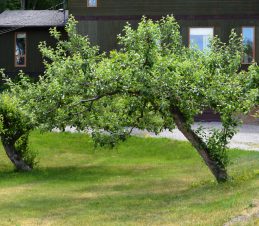
Maintain your Tree at a Managable Height
Maintaining your trees at a height between 10 and 12 feet will keeps the fruit-bearing zone low making it easier for homeowners to scout and manage pests or remove infested fruit. This can be done by pruning and training (tying down) upright limbs.
Planting fruit trees that are grown on dwarfing and semi-dwarfing rootstock in another option that can help home owners manage their fruit trees because the overall mature height of the tree will only be between 10 and 12 feet.
-
Tree Species
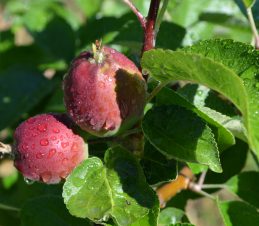
Early-maturing varieties of trees can mean you will avoid a third generation of codling moth. If you are planting a new tree consider selecting an early-maturing variety.
-
Removal of Debris Under Tree

Remove Infested Fruit and Debris From Under Trees
After feeding on the fruit, larvae drop from the trees to search out pupation sites under the bark, soil or on debris under the tree.
Make sure the area under your tree is clear of trimmings, old wood, ladders, and anything else the larvae might use as a place to cocoon.
-
Pruning
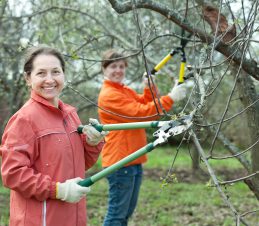 Good fruit tree management requires regular pruning.
Good fruit tree management requires regular pruning.Prune and open up the tree canopy during the dormant season (November to March). A well-pruned tree has an open and low canopy.
A low canopy makes for easier detection of infested fruit. An open canopy allows for more consistent spray coverage, if you have to spray, and reduces diseases like apple scab.
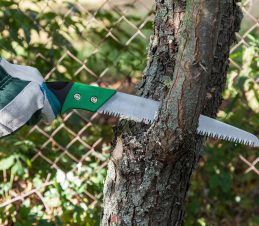 For more information, refer to the page on How to Prune an Apple Tree.
For more information, refer to the page on How to Prune an Apple Tree.For information on hard pruning see the dropdown below, “Hard Pruning”.
-
Inspection
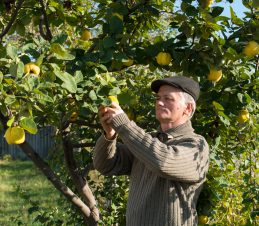
Inspecting a Quince Tree
Homeowners should inspect for evidence of codling moth infestation in their trees throughout the summer.
Check your tree every week, beginning about six weeks after bloom, for signs of damage. Infested fruit often ripens prematurely and falls to the ground. Keep your eyes open for unusually ripe fruit on the tree or ground.
-
Stripping – Removal of all Blossoms and Fruit
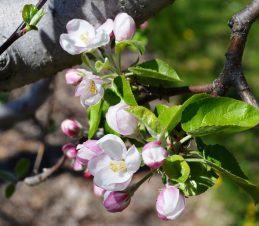 No flowers = no fruit.
No flowers = no fruit.Removing blossoms and fruit from trees is recommended for homeowners who want to keep their trees but have codling moth infestations. This is also good for those not interested in the fruit, or caring for their tree that season.
Snip off all blossom stems that appear in early spring. Continue to check the trees throughout the season and remove all missed fruit or new blossoms. Stripping will not harm your tree.
-
Thinning
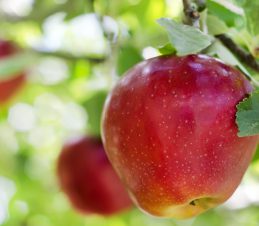 If you wish to harvest your apples at the end of the season, thinning fruit to singles will reduce the risk of attack by the larvae.
If you wish to harvest your apples at the end of the season, thinning fruit to singles will reduce the risk of attack by the larvae.Thinning out also encourages the remaining fruit to grow larger, and makes it easier to spot infested or diseased fruit.
-
Bagging Fruit
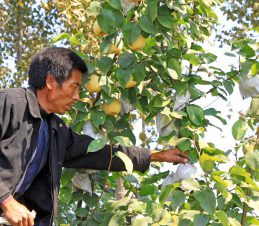
Bagging Fruit on a Quince Tree
Good quality fruit production can be achieved by enclosing young fruit in bags right on the tree to protect them from the codling moth. It is quite time consuming to apply the bags, so this method is most manageable on smaller trees with fewer fruit.
When the fruit is less than 3 cm (1 inch) in diameter, individually bag each fruit left on the tree. Standard paper bags or commercially available apple bags can be used. Bagging provides a barrier to keep codling moth adults and larvae off the fruit. Bags should be removed one or two weeks before fruit harvest to allow for proper colour development on the fruit’s surface.
-
Cardboard Banding

Cardboard Banding | Image Source: Tom Walker
Banding can work as a trap for mature codling moth larvae. Place a 10 cm (4 inches) corrugated cardboard band around the lower trunk, or scaffold, 2 or 3 main branches of the tree to attract larvae searching for a place to pupate. You must remove and destroy the bands and any cocoons on the tree before the adult moths begin to emerge at each lifecycle during the season.
The codling moth can produce from 1 to 3 generations per year in the interior of BC depending on the season, so new bands should be placed on the tree at least 2 times per season.
Banding will only capture a 30-40% portion of the codling moth present on a tree; and banding only captures codling moth larvae after they have infested the fruit on the tree. If bands are not removed or destroyed multiple times per season, they will not help decrease the codling moth population.
SIR may apply and remove the bands for you if your home is near a commercial orchard. SIR uses banding as a monitoring tool, not a management tool.
-
Removal of Infested Fruit
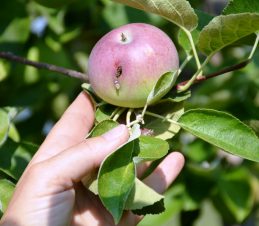
Image Source: Tom Walker
Remove and destroy any infested fruit showing the frass-filled holes, or “wormy” fruit. Pick up any infested fruit on the ground beneath the tree as the codling moth larvae will continue to feed and develop within the dropped fruit. Continually remove infested fruit on the tree throughout the growing season.
Removing and disposing of infested fruit before the larvae are old enough to crawl out and begin the next generation can be a very effective method of reducing the population.
All infested fruit should be destroyed. Options include crushing or burying infested fruit, sending it to the landfill or placing it in a bucket of water for several days to drown the larvae. Do not compost infested fruit. Composting fruit allows moth larvae to continue their life cycle.
-
Harvest
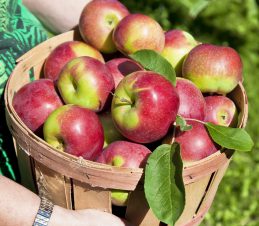
Apple Harvest
Harvest all fruit completely in the fall.
-
Hard Pruning
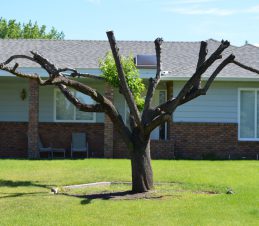 Hard pruning is a pruning technique that removes a lot of wood and all the young growth branches. By removing so much growth, there will be no fruit in the upcoming season and you eliminate the food source of the codling moth.
Hard pruning is a pruning technique that removes a lot of wood and all the young growth branches. By removing so much growth, there will be no fruit in the upcoming season and you eliminate the food source of the codling moth.This is the easiest method of getting rid of a codling moth infestation on your property.
Apple trees are one of the few deciduous trees that will bounce back from a hard, single-year shortening.
How to do Hard Pruning
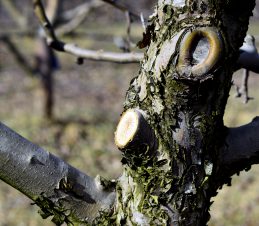 Open the centre of the tree by removing larger branches at point of origin with a sharp pruning saw. Select five or six evenly spaced branches to keep as the main scaffold branches. Head back the tips of the main branches to about one-third their total length. Determine the amount of height that needs to be removed to provide better access for fruit inspection and tree care in the future.
Open the centre of the tree by removing larger branches at point of origin with a sharp pruning saw. Select five or six evenly spaced branches to keep as the main scaffold branches. Head back the tips of the main branches to about one-third their total length. Determine the amount of height that needs to be removed to provide better access for fruit inspection and tree care in the future.Eliminate any rubbing or crossing branches, cutting them back to the point of origin on the parent branch or back to an outward-facing branch or bud. Eliminate inward-growing branches; cut the entire branch back to the parent branch or cut to an outward-growing bud or branch. Eliminate branches with weak angles in favour of branches with 60- to 90-degree branch crotches. Selectively remove additional branches until a hard pruned canopy is cleared.
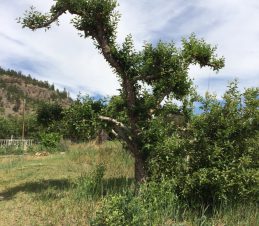 When you make severe cuts to reduce the height of the tree, the tree responds by sending out vigorous upright shoots. You must remove these shoots to keep a manageable tree height over the next couple years. Removing these shoots regularly will also encourage fruiting on the lower branches in future years.
When you make severe cuts to reduce the height of the tree, the tree responds by sending out vigorous upright shoots. You must remove these shoots to keep a manageable tree height over the next couple years. Removing these shoots regularly will also encourage fruiting on the lower branches in future years.

